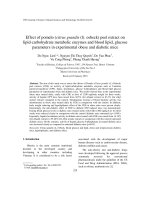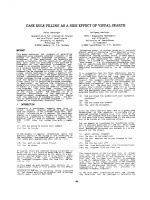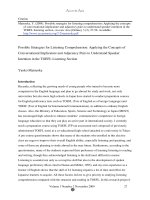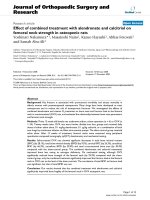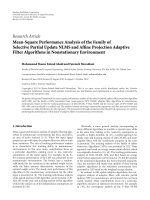Omni-Channel Shopper Analysis: Effect of Mobile Search, Belief Structure, and Salesperson Input on Shopper Purchase Intention in Retailing Market
Bạn đang xem bản rút gọn của tài liệu. Xem và tải ngay bản đầy đủ của tài liệu tại đây (1.02 MB, 19 trang )
Omni-Channel Shopper Analysis: Effect of Mobile Search, Belief
Structure, and Salesperson Input on Shopper Purchase Intention in
Retailing Market
Nguyen Thi Hoang Mai
Ho Nhut Quang
Nguyen Tan Minh
International University, Vietnam National University HCMC, Vietnam
Abstract
It is undeniable that shoppers these days are more empowered, demanding, interactive, collaborative, and
diverse which all thanks to the globalization and internet of thing development. Therefore, retailing market is
in stronger competition than ever. To deeply understand the shoppers who access full of different channels
before purchase decision (omni channel shoppers), this research aims to explore what determinants
influence the shoppers purchase intention by proposing the conceptual framework and quantify the degree of
these affects by applying Statistical Package for the Social Science (SPSS) software and analyzing the data
through Confirmatory Factor Analysis (CFA) as well as Structural Equation Modelling (SEM).
After analyzing the data sample from 466 omni channel shoppers in Ho Chi Minh city, shoppers purchase
intention is strongly and positively affected by Attitude, Subjective Norm, Mobile Search, and Predisposition
to Comply with Salesperson Input, meanwhile there are three components indirectly influencing purchase
intention, comprising of Mobile Dependence, Predisposition to Comply with Mobile Divide Input, and
Adaptive Selling.
Therefore, retailers are suggested to utilize and broaden the product information both in online and offline,
yet the important thing is how to gain the trust and reliable sensation from shoppers through salesperson
adaptive selling and prestigious online information from social network or information accessibility in
everywhere, every time, and everyplace that shoppers are able to search and look for.
Keywords: Omni-channel Shopper, Mobile Search, Belief Structure, Salesperson Input, Shopper purchase
intention
1. Introduction
The global retailing market trends are composed by new technology adaptation, convenience format
demand, booming of E-commerce, artificial intelligent & virtual reality and prospective omni-channel. It is,
hence understand that though shoppers are busier in daily life, still fully utilizing the remarkable development
of shopping means by various choices, more accessible at different channels. Shoppers, additionally, have
higher demands, empower more diversity of selections, obtain numerous knowledge, and always keep the
dated movement.
843
Verhoef et al. (2015, p176) dedicates omni-channel retailing as “the synergetic management of the
numerous available channels and customer touchpoints, in such a way that the customer experience across
channels and the performance over channels is optimized”. Indeed, omni-channel provides seamless
experiences toward shoppers in different channels, yet, they are united structure and available accessibility.
Additionally, based on (Fairchild, 2014), omni-channel retailing combines traditional with e-commerce
through the integration of business management, aiming to well serve customer demand, regardless of place
or time, and create a seamless shopping experience. Undoubtedly, following to the technology development,
things are integrated in portal devices, shopping is no exception. Omni-channel allows shopper to collect
information in one channel, experience products from other channel and even make purchasing decision in
other retailing means.
In order words, omni-channel customer experience occurs when customers can order or book in advance
from one channel (eg. online), pick up at brick and mortar shop, and return in another third channel (Solomon,
2005).
Each retailer, for detail, should get on well with the shoppers’ trend and their shopping wisdom in other
to win shopper in every channel where optimize the most approachable selling methods. Besides, brick and
mortar retail owners are competing with ecommerce platform, this paper will illustrate clearer reasons why
brick and mortar retailers are better to unite with technology competencies, hence bring the outstanding
outcomes. “Online and physical stores are complementary, not rivals. They must unite together to increase
turnover which is the key to a successful Omni-channel strategy.” By Philippe Humeau, CEO, NBS System
(2014).
Aiming to explore which attributes influence the shopper purchase intention in the current retailing
market, then analysis the relationship and correlation among these factors are two fundamental research
purposes. Retailers, therefore, are inevitably able to apply in their business and sales strategies to boost up the
net profit.
2. Literature Review and Hypothesis Development
Ajzen & Fishbein, 1980 suggest that attitude means a person feels of favorableness or unfavorableness
toward the behavior. People are willing to carry out the behavior in case they are belief in their evaluation of
expected results, in other words, attitude is a function of perceived outcomes weighted by a judgement of the
desirability consequences. In this research context, shoppers are likely to buy one product, when they evaluate
their behavior of purchasing which is good and will bring a beneficial result as their wishes.
According to Shirley Taylor &Peter Todd, 1994, when a person has strong self confidence in their
desirability results, they are likely to perform their behavior intention. Also, customers whose perspective
contains more trust toward firm, sales staff, or both (Doney and Cannon (1997), the trust obtains a positive
and direct effect on consumer attitude in purchasing intention (Pavlou & Fygenson, 2006). Importantly, based
on Theory of Reasoned Action one’s attitude has been concluded to influence on behavior performance (Ajzen
& Fishbein, 1980). Therefore, leading to the first hypothesis,
H1: A consumer’s high self-evaluation in purchasing outcomes is positively related to their purchase intention.
A person is affected or perceived by social pressure (Ajzen & Fishbein, 1980), especially, by who is
considered important. In order words, people tend to implement the behavior if they belief in particular
references which are weighted by the encouragement to perform with these recommendations. Following with
the study about omni-channel shopper, shoppers are inclined to purchase goods or not which likely depends
on their trust on related references, others’ acts, and social influence.
A consumer’s personal community tends to apply social pressure in other to make decision in purchase
(Young&Kent, 1985). Additionally, from Engels at. Al (2001) shows that shoppers who get or receive advice
844
from friends or parents to buy one product are likely to purchase following the advices comparing to one who
has no information or suggestion. (Conner et al., 2001). Hence, the second hypothesis,
H2: A consumer’s subjective norm from respectful references is positively related to their purchase intention.
Perceived behavior control reveals one’s belief in relation to access to capabilities or resources and
opportunities needed to execute the behaviors. It includes two main components (Ajzen, 1991; Taylor & Todd,
1995).
The first mentioned component is availability facilitation comprising of time, money, location, and so on.
Omni-shopper, specifically, are likely to purchase if the surrounding conditions are convenient and
advantageous to shoppers’ perception in that case.
The second component is the focal person’s self-confidence in the competence to control and conduct the
behavior. For instance, one person will be more determined to drive a car, unless he is doubt about the driving
difficulty. In sales situation, shoppers will have more belief and confidence to purchase their desirability
products when they believe in self-efficacy to easily use or operate these goods.
Following Ajzen, 1991, 2002, controlling perception is able to motive action when shoppers have enough
time, money, information, etc also their self-confidence in carry out the purchasing behavior. It is an apparent
fact that consumers have more perceived behavior control which is observed linked with multi/omni channel
consumers purchase decision (Rippé at al., 2015; Rippé, Weisfeld-Spolter, Yurova, Hale, &Sussan, 2016). The
third testing hypothesis,
H3: A consumer’s perceived behavior control in their facilitation and self-efficacy is positively related to their purchase
intention.
These days, retail industry have been empowered by consumer’s technology usage, especially, MobileCommerce (M-commerce). Following Balasubramanian, Peterson, & Javenppa, 2002, M-commerce allows
interaction and communication between people and smart devices. Mobile device input, literally, is
informational provider, yet, it also a clever device which suggest a number of helpful recommendation from
social network or connected integration.
Predisposition to comply with mobile input play an important role in shoppers’ purchase intention. It
represents how strong an individual tends to consider and apply the information from mobile devices, hence
influencing shopper’s buying decision. Or simply understand mobile device input as social recommendation
assist shoppers in gaining information, price, place, delivery, quality, and so on.
According to Hubert at al.,2017; Rippé at el., 2015, using mobile technology to stronger engage customers
during searching effort is a potential opportunity for retailers. Aiming to search more efficient in mobile
devices, application usage has been proved to influence on purchase behavior (Kowatsch&Maass,2010). The
more shoppers are willing to make use of technology, the more searching information they know. Kim, Wang,
and Malthouse (2015) found that the number of interactive app functional features, the higher purchase
intention spending rate, following by,
H4: A consumer’s predisposition to comply with device input is positively related to mobile search.
Following Jun&Park (2016), search using a mobile device is rising significantly and continuingly, Bachrach,
Ogilvie, Rapp, & Calamusa, 2016 show that consumers are replacing traditional searches from magazine,
newspaper, guidebooks, etc with smart phone optimized searching. Some consumers prefer to search deals,
compare prices, and probe the previous reviews in advances, before visiting a retail shop (Gundlach, Manning,
& Cannon, 2011).
Thanks to high technology application, smart phone is more and more playing a key role in people lives.
With an appeal platform, user feels easy to search for needed information everywhere, every time and with a
low cost of searching, shoppers have more reasons to choose mobile as their shopping assistant who is fast,
durable, various information, and even can connected socially.
Increasingly, consumers rely more on their mobile devices (Shoham & Pesämaa, 2013). It is thought that
mobile devices allow omni-channel shoppers to interact and personalize the product information in high-
845
speed, various knowledge sources, and accessibility in everywhere, every time. “Mobile optimized and search
engine friendly retail sites are likely to accelerate search and discovery” from Shankar at al. (2016, p.41). Based
on that, the hypothesis is built,
H5: A consumer’s mobile dependence is positively related to mobile search.
Purchase intention is defined by Shabbir, M. S., Kirmani, S., Iqbal, J., & Khan, B.2009 that purchase intention
is an individual’s consciousness to make an effort to buy a brand. While Park,J.2002 defines purchase intention
is “what we think we will buy”. Another researcher explains purchase intention as an acting decision or
psychology process showing person’s behavior based on purchased products (X.Wang &Yang, 2008).
Shopper may be the one who will use the product, or they may simply just purchase for the other’s usage.
Shoppers decide to buy something when their intention towards the purchasing behavior or when their action
inclines desirably to owning products for satisfying their using purposes.
As
discuss
above,
consumers
search
online
information
for
comparing
price/product/place/promotion/etc, checking previous reviews, and so on which is searching around, yet in
one place and in one mobile device. Thanks to a great number of convenient function on mobile search,
customers are likely to rely more on searching in advance by their smart devices, then they are able to easily
make purchasing decision instore. Next, hypothesis is,
H6: A consumer’s mobile search is positively related to their purchase intention.
Weitz, Sujan, & Sujan, 1986, p.175 define adaptive selling as “altering of sales behavior during a customer
interaction or across customer interactions based on perceived information about the nature of the selling
situation. Selling methods should be adjusted in real time toward shoppers’ purchasing process in other to
satisfy shoppers’ expectation as well as retail stores.
A scholar demonstrates that consumer satisfaction is higher when retail salespersons adapt their behavior
or selling techniques to shopper’s reference for interaction or further relationship (Olsen & Skallerud, 2011).
In addition, Yurova, Pippé, Weisfeld-Spolter, Sussan, and Arndt (2016) figured out that interactive adaptive
selling performance comprises of adjusting selling skills, solutions, appearance, presentations which are
influencing omni-channel shopper.
How flexible and modifying in selling method in retail store are likely to affect on shoppers’ purchasing
behaviors, in deed, customers are easier to discuss on their desirability or demand with the understanding or
professional employees since it is believed that good interaction and conversation lean on effective influences.
Adaptive selling efforts perhaps show the tempt of salesperson inputs which is positively considered by
customers that they receive a good recommendation and value- added through product by in person
interaction. Rippé, 2015 concluded that retail salesperson can apply adaptive selling in their selling methods
in other to boost up omnichannel shoppers’ feeling of perceived behavior control. Therefore,
H7: A salesperson’s use of adaptive selling is positively related to a consumer’s predisposition to comply with
salesperson input.
Salesperson input or predisposition to comply with salesperson input is consumer’s tendency to rely on
salesperson’s consult during the buying process or shopping journey. Based on Goff & Jackson (2003), the
more consumer recognizes the salesperson has high customer-oriented while less salesperson-oriented. In
order way to explain the idea, shoppers are easily influenced by the salesman only if he puts himself as a
customer and give helpful advices rather than simply want to sell products. Additionally, salesperson input
includes provided information, sharing skills, creating further relationship with shoppers.
Besides, Sun et al. (2009) expressed as much as consumer’s interdependence in self-construal which
supports to explain their inclination toward salesperson effect on public self-consciousness.
Experts’ power is strong when product information and salesperson knowledge are shown in-store and
effectively approach to shoppers perceive (Harris&Spiro,1981). When customer is impressed by salesperson’s
expertise and professional as well as positive performance, they are more likely to influenced and want to
interact or develop relationship, hence shoppers are capable of receive trustworthy consultant. The trust is set
846
up adding with salesperson’s expertise, credibility and relationship between shopper and salesperson can
influence customer’s purchase intention in-store. Thus, the final hypothesis is,
H8: A consumer’s predisposition to comply with salesperson is positively related to their purchasing intention.
Belief Structure
Attitude
H1(+)
Purchase
Intention
H2(+)
Adaptive
Selling
Subjective
Norm
Perceived
Behavior
Control
H7(+)
H8(+)
H6(+)
H3(+)
Predisposition to
comply with
salesperson input
Mobile Search
H5(+)
H4(+)
Mobile
Dependence
Predisposition to comply
with device input
Figure 1: Conceptual Framework
3. Methodology
Conceptual Framework
The above model is proposed by collecting from secondary data and researching from the previous works.
Since combining a number of rela��������������������������������������������������������������������������������������������������������������������������������������������������������������������������������������������������������������������������������������������������������������������������������������������������������������������������������������������������������������������������������������������������������������������������������������������������������������������������������������������������������������������������������������������������������������������������������������������������������������������������������������������������������������������������������������������������������������������������������������������������������������������������������������������������������������������������������������������������������������������������������������������������������������������������������������������������������������������������������������������������������������������������������������������������������������������������������������������������������������������������������������������������������������������������������������������������������������������������������������������������������������������������������������������������������������������������������������������������������������������������������������������������������������������������������������������������������������������������������������������������������������������������������������������������������������������������������������������������������������������������������������������������������������������������������������������������������������������������������������������������������������������������������������������������������������������������������������������������������������������������������������������������������������������������������������������������������������������������������������������������������������������������������������������������������������������������������������������������������������������������������������������������������������������������������������������������������������������������������������������������������������������������������������������������������������������������������������������������������������������������������������������������������������������������������������������������������������������������������������������������������������������������������������������������������������������������������������������������������������������������������������������������������������������������������������������������������������������������������������������������������������������������������������������������������������������������������������������������������������������������������������������������������������������������������������������������������������������������������������������������������������������������������������������������������������������������������������������������������������������������������������������������������������������������������������������������������������������������������������������������������������������������������������������������������������������������������������������������������������������������������������������������������������������������������������������������������������������������������������������������������������������������������������������������������������������������������������������������������������������������������������������������������������������������������������������������������������������������������������������������������������������������������������������������������������������������������������������������������������������������������������������������������������������������������������������������������������������������������������������������������������������������������������������������������������������������������������������������������������������������������������������������������������������������������������������������������������������������������������������������������������������������������������������������������������������������������������������������������������������������������������������������������������������������������������������������������������������������������������������������������������������������������������������������������������������������������������������������������������������������������������������������������������������������������������������������������������������������������������������������������������������������������������������������������������������������������������������������������������������������������������������������������������������������������������������������������������������������������������������������������������������������������������������������������������������������������������������������������������������������������������������������������������������������������������������������������������������������������������������������������������������������������������������������������������������������������������������������������������������������������������������������������������������������������������������������������������������������������������������������������������������������������������������������������������������������������������������������������������������������������������������������������������������������������������������������������������������������������������������������������������������������������������������������������������������������������������������������������������������������������������������������������������������������������������������������������������������������������������������������������������������������������������������������������������������������������������������������������������������������������������������������������������������������������������������������������������������������������������������������������������������������������������������������������������������������������������������������������������������������������������������������������������������������������������������������������������������������������������������������������������������������������������������������������������������������������������������������������������������������������������������������������������������������������������������������������������������������������������������������������������������������������������������������������������������������������������������������������������������������������������������������������������������������������������������������������������������������������������������������������������������������������������������������������������������������������������������������������������������������������������������������������������������������������������������������������������������������������������������������������������������������������������������������������������������������������������������������������������������������������������������������������������������������������������������������������������������������������������������������������������������������������������������������������������������������������������������������������������������������������������������������������������������������������������������������������������������������������������������������������������������������������������������������������������������������������������������������������������������������������������������������������������������������������������������������������������������������������������������������������������������������������������������������������������������������������������������������������������������������������������������������������������������������������������������������������������������������������������������������������������������������������������������������������������������������������������������������������������������������������������������������������������������������������������������������������������������������������������������������������������������������������f attitude and subjective norm toward product quality, expected using results and
850
recommendation from important relatives. Therefore, not only manufacturing qualified products, but also
showing and creating the belief in shoppers’ perception even more important.
Since belief provides a reason and motivation to make a purchase, do not always talk about the product
quality, rather than retailers are better to let shopper experience the product themselves. By truly experience
the product, gain certain using feelings, shoppers are more confident in purchasing after their good trial
results.
Furthermore, continuously improving the product standard by market research, qualitative examine,
exhibition, market fair, and so on is extremely essential. By in-dept interview what shopper needs, shopper
expectation, manufacturers and retailers have more useful and accurate information to serve make gain the
trust from shoppers.
Doing marketing campaign with experts is inevitably trustworthy. Indeed, talk shows with experts not
only provide reliable specialist information, but also build up shopper trust by experts’ knowledge and
guarantees instead of one-way information from retailers only.
In short, the initial elements turn shoppers into purchase is the attitude of belief. By adapting real emotional
experience, introducing products through famous and prestigious exhibition, or holding expert talk shows,
omni channel shoppers obtain diversified channels and reliable evaluation for their purchase intention.
Mobile Search
Following the research findings and data analysis above, mobile search is significantly vital for before and
after purchasing. Most of the respondents agree with the searching on their mobile supporting them have a
better and easier selection. Thus, there are several methods to approach omni channel shoppers.
Firstly, information accessibility is always available in the internet so that shoppers find accessible to the
products everywhere and every time they are convenient and needs. The research findings show that before
any purchase, shoppers tend to look for different types of products by mobile search which is saved-time and
saved-money as well as boost up the shoppers’ interest in shopping process.
Secondly, develop interactive marketing which provides platforms where shoppers are able to truly
involve in their positive and recommended feedbacks. Playing as e-word of mouth, interactive marketing
enhances the products fame naturally by previous users, besides retailers provide more promotion or grant to
loyal and recommended shoppers or mobile apps where shoppers and retailer attain closer connection
everywhere, everyplace and every time. Indeed, information from the retailers is not fully reliable enough to
shoppers, instead they need more broaden information from previous buyers. Products, thus, gain more
attention from the shoppers since there are a number advised reviews online that shoppers are willing to try
rather than buying a product without information at all.
Mobile Dependence
Since mobile dependence positively affects the mobile search frequency and purposes. The more shoppers
depend on their mobile, the more searching needs they get, therefore, information strongly ought to be
accessible on company websites, google recommendation, google map, social network, online news, and so
on. Thanks to a powerful function of internet, products are easier in term of marketing, yet should be expanded
as broad as possible to increase the awareness as well as interaction with buyers. In short, product information
and promotion program should be appeared on every channels (email, tracking online shopping list, online
cart).
Predisposition to Comply with Mobile Divide Input
851
When users frequently comply with their mobile searching information, the more searching habit they
have. By positive correlation between predisposition to comply with mobile divide input and mobile search,
products obtain higher chance of knowing and purchasing by shoppers found on searching divide.
Once again, this factor emphasizes the strong power of information on mobile search, hence, the most
essential keyword is to make the information broaden yet have to be reliable. In order make information
trustful, retailers are advisable to publish positive rating votes from previous buyers, post product information
feedbacks on prestigious websites, and others.
In summary, shoppers tend to reply and commit with mobile searching input when they emotionally
believe in the online information they get from diversified sources in the internet.
Predisposition to
Comply with Salesperson Input
Regarding to the data analysis, predisposition to comply with salesperson input plays the highest level of
influence on shopper purchase intention which means salesperson recommendation and advices are highly
considered by shoppers. Therefore, retailers should pay significant attention on delivering salesperson values
towards shoppers.
Specifically, rather than paying too much effort on selling products, salespersons are better to spend time
on understand what customers’ needs and their consideration. Since well understanding, salespersons not
only provide good and suitable solution but also connect with shoppers as closer relationship.
Besides, retailers are better to train salesperson skills on how to increase the loyalty that shoppers would
like to come back and make another purchase by delivering reason to believe, company and product quality
commitment, showing real previous shoppers recommendation, applying sample testing before purchase, and
so on.
Furthermore, shoppers highly desire to get more involvement and support from salesperson who should
be the one understands the different kinds of products the most.
Adaptive Selling
The data analysis show that adaptive selling is one of the factor positively affecting the predisposition to
comply with salesperson input, which illustrates the importance of being flexible and adaptive of salesperson
in different shoppers, contexts, and expectation.
These days in Vietnam retailing market, shoppers have more power and accessibility to make purchase
decision, hence, salespersons need to add more value from relationship connection, useful advices, and
adaptive as well as responsive in shoppers’ requests.
By adapting suitable selling methods, shoppers are easily to engage more with salesperson input.
6. Conclusion
In general, the fundamental paper purpose is to explore which factors and their relationship effect on
omnichannel shoppers purchase intention in retailing market by survey method with 466 Ho Chi Minh
shoppers and SEM data analysis test. Additionally, retailers should be aware of the shopping journey
changings as well as shopper’s intention on using all available channels (brick – mortar stores, online
shopping, catalogue, and so on), thus suggesting the retailers widen reliable information and accessible
approaches toward shoppers.
7. Limitation and Future Research
Regarding toward the limitation, some statement in the measurement scales are originally in English, hence
it is undeniable there are some limits in translation part where the original meanings are transferred in another
852
language. In addition, this study scopes into Ho Chi Minh shoppers thus, less likely to represent the big
population in Vietnam (around ninety-five million people). Besides, total correlation between independent
(Attitude, Mobile Search, Predisposition to Comply with Salesperson Input) and dependent factors (Purchase
Intention) is approximately 94% which means there are others auxiliary factors can support the conceptual
model to be improved.
There are two main other aspects that future researches are able to complete. Firstly, based on the SEM
analysis, these correlations are significant without being tested in this research ( Mobile Dependence and
Adaptive Selling, Adaptive Selling and Attitude, Attitude and Predisposition to Comply with Mobile Divide
Input).
Further research should extend the sample size as well as test in another data collection methods.
Furthermore, the future researches are advised to re-measure the un-supported hypothesize in this paper. The
future research, hence, is prominent to reconfirm the hypothesize as well as comparing the results with
antecedent studies.
References
853
Ajzen, I. (2002). Perceived behavioral control, self-efficacy, locus of control, and the theory of planned behavior. Journal of Applied Social
Psychology, 32(4), 665–683.
Ajzen, I., & Fishbein, M. (1980). Understanding attitudes and predicting social behavior. Englewood Cliffs, NJ: Prentice-Hall.
Ajzen, Icek, 1985. From Intentions to Actions: A Theory of Planned Behavior, in Action Control: From Cognition to Behavior, eds. J. Kuhl
and J. Beckmann, New York: Springer Verlag, 11-39.
Ajzen, Icek, 1987. Attitudes, Traits, and Actions: Dispositional Prediction of Behavior in Personality and Social Psychology, Advances in
Experimental Social Psychology, 20, 1-63.
Ajzen, Icek, 1989. Attitude Structure and Behavior, in Attitude Structure and Function, eds. Anthony Pratkanis, Steven Breckler, and
Anthony Greenwald, Hillsdale, NJ: Erlbaum, 241-274.
Ajzen, Icek, 1991. The Theory of Planned Behavior, Organizational Behavior and Human Decision Processes, 50, 179-211.
Bachrach, D. G., Ogilvie, J., Rapp, A., & Calamusa, J. (2016). Price matching: To match or not to match? More than a showroom: Strategies for
winning back online shoppers (pp. 93–108). New York: Palgrave Macmillan US.
Bagozzi, Richard P. (1981). An examination of the Validity of Two Models of Attitude. Multivariate Behavioral Research, 16, 323-359.
Balasubramanian, S., Peterson, R. A., & Jarvenpaa, S. L. (2002). Exploring the implications of m-commerce for markets and marketing.
Journal of the Academy of Marketing Science, 30(4), 348–361.
Burnkrant, Robert E. and Thomas J. Page, 1988. The Structure and Antecedents of the Normative and Attitudinal Components of
Fishbein's Theory of Reasoned Action, Journal of Experimental Social Psychology, 24, 66-87.
Chiou, J. S. (1998). The effects of attitude, subjective norm, and perceived behavioral control on consumers’ purchase intentions: The
moderating effects of product knowledge and attention to social comparison information. Proc. Natl. Sci. Counc. ROC (C), 9(2), 298308.
Chirstine Thelander, 2015. Retrieved from />Claes Fornell and David F. Larcker Journal of Marketing Research Vol. 18, No. 1 (Feb., 1981), pp. 39-50
Conner, M., Kirk, S. F. L., Cade, J. E., & Barrett, J. H. (2001). Why do women use dietary supplements? The use of the theory of planned
behaviour to explore beliefs about their use. Social Science and Medicine, 52(4), 621-633.
Doney, P. M., & Cannon, J. P. (1997). An examination of the nature of trust in buyer-seller relationships. Journal of Marketing, 61(2), 35-51.
Engels, Y., van Assema, P., Dorant, E., & Lechner, L. (2001). Factors associated with the intention to use vitamin D supplements:
Quantitative study among a sample of elderly people in a mediumsized town in the Netherlands. Journal of Nutrition Education, 33(3),
134-141.
Fairchild, A.M. (2014), “Extending the network: defining product delivery partnering preferences for omni-channel commerce”, Procedia
Technology, Vol. 16, pp. 447-451.
Fishbein, M., & Ajzen, I. (1975). Belief, attitude, intention and behavior: An introduction to theory and research.
Fishbein, Martin A. and Icek Ajzen, 1975. Belief, Attitude, Intention and Behavior: An Introduction to Theory and Research, Reading MA:
Addison-Wesley.
Fishbein, Martin A., 1967. Readings in Attitude Theory and Measurement, New York: Wiley
George, D., & Mallery, P. (2003). SPSS for Windows step by step: A simple guide and reference 11.0 update (4th ed.). Boston: Allyn & Bacon
Goff, B. G., & Jackson, G. B. (2003). Customers’ perceptions of salespersons’ orientation and susceptibility to salespersons’ influence.
Psychological Reports, 93(2), 417–418.
Greenland,
S.
&
Newman,
A.
(2015).
Retail
Distribution
Channels.
Wiley
Encyclopedia of Management. 9:1–2.
Grube, Joel W., Mark Morgan, and Sheila T. McGree, 1986. Attitudes and Normative Beliefs as Predictors of Smoking Intentions and
Behaviours: A Test of Three Models, British Journal of Social Psychology, (25), p. 81-93.
Gundlach, G. T., Manning, K. C., & Cannon, J. P. (2011). Resale price maintenance and free riding: Insights from multi-channel research.
AMS Review, 1(1), 18–31.
Hair,
J.
F.,
Anderson,
R.
E.,
Tatham,
R.
L.
&
Black,
W.
(1998).
Multivariate
Data
Analysis. 5ed. Upper Saddle River: Prentice Hall.
Hair,
J.
F.,
Barry
J.B.,
Arthur
H.
M.,
Philip
S.
(2003).
Essentials
of
business
research
methods
(International
ed).
John
Wiley
&
Sons,
Inc.
Hair,
J.
F.,
Bush,
P.
R.
&
Ortinau,
J.
D.
(2006).
Marketing
Research:
Within
a
Changing
Information Environment. Revised International Edition. Boston: McGraw-Hill.
Hair,
J.,
Black,
W.,
Babin,
B.,
and
Anderson,
R.
(2010).
Multivariate
data
analysis
(7ed.).
Prentice-Hall,
Inc.
Upper
Saddle
River,
NJ,
USA.
Retrieved
from:
/>Harris Interactive. (2013). Showrooming not slowing down, according to recent Harris poll. Retrieved from
/>efault.aspx.
Harris, C. E., & Spiro, R. L. (1981). Training implications of salesperson influence strategy. Journal of Personal Selling & Sales Management,
1(2),10–17.
Hubert, M., Blut, M., Brock, C., Backhaus, C., & Eberhardt, T. (2017). Acceptance of smartphone-based mobile shopping: Mobile benefits,
customer characteristics, perceived risks, and the impact of application context. Psychology & Marketing, 34(2), 175–194.
Jin, B., & Hong, B. (2004). Consumer susceptibility to salesperson influence in Korean department stores. Journal of International Consumer
Marketing, 17(1), 33-53.
Jöreskog, K. G. (1970). A General Method for Analysis of Covariance Structures. Biometrika, 57, 239-251.
Jöreskog, K. G. (1971). Statistical analysis of sets of congeneric tests. Psychometrika, 36, 109-133.
Jun, S.-P., & Park, D.-H. (2016). Consumer information search behavior and purchasing decisions: Empirical evidence from Korea.
Technological Forecasting and Social Change, 107, 97–111.
Kim, J., & Hahn, K. H. Y. (2015). The effects of self-monitoring tendency on young adult consumers’ mobile dependency. Computers in
Human Behavior, 50, 169–176.
Kim, S. J., Wang, R. J.-H., & Malthouse, E. C. (2015). The effects of adopting and using a brand’s mobile application on customers’
subsequent purchase behavior. Journal of Interactive Marketing, 31, 28–41.
854
Kowatsch, T., & Maass, W. (2010). In-store consumer behavior: How mobile recommendation agents influence usage intentions, product
purchases, and store preferences. Computers in Human Behavior, 26(4), 697–704.
Mobile shopper marketing: Key issues, current insights, and future research avenues. Journal of Interactive Marketing, 34, 37–48.
Moran,
J.
W.
&
Brightman,
B.
K.
(2001).
Leading
organizational
change.
Career
Development
International, 6(2), 111–118
Olsen, S. O., & Skallerud, K. (2011). Retail attributes’ differential effects on utilitarian versus hedonic shopping value. Journal of Consumer
Marketing, 28(7): 532–539.
Pavlou, P. A., & Fygenson, M. (2006). Understanding and predicting electronic commerce adoption: An extension of the theory of planned
behavior. MIS Quarterly, 30(1), 115-143.
Philippe Humeau, CEO, NBS System (2014). Retrieved from />Pire
(2007),
Structural
Equation
Modelling
Workshop.
Retrieved
from:
/>Pookulangara, S., Hawley, J., & Xiao, G. (2011). Explaining consumers’ channel-switching behavior using the theory of planned
behavior. Journal of Retailing and Consumer Services, 18(4), 311-321.
Retrieved from Kantar World Pannel market research report, Euro Asia, and Accenture’s Nonstop-Customer Experience Model
Rippé CB, Weisfeld-Spolter S, Yurova Y, Dubinsky AJ, Hale D. Under the sway of a mobile device during an in-store shopping experience.
Psychol Mark. 2017;34:733–752.
Rippé, C. B., Weisfeld-Spolter, S., Yurova, Y., & Sussan, F. (2015). Is there a global multichannel consumer? International Marketing Review,
32(3/4), 329–349.
Rippé, C. B., Weisfeld‐Spolter, S., Yurova, Y., Dubinsky, A. J., & Hale, D. (2017). Under the sway of a mobile device during an in‐store
shopping experience. Psychology & Marketing, 34(7), 733-752.
Rippé, C. B., Weisfeld-Spolter, S., Yurova, Y., Hale, D., & Sussan, F. (2016). Guiding when the consumer is in control: the moderating effect
of adaptive selling on the purchase intention of the multichannel consumer. Journal of Consumer Marketing, 33(6), 469-478.
Rogers, Everett M., 1983. Diffusion of Innovations: Third Edition, New York: Free Press. Shankar, V., Kleijnen, M., Ramanathan, S., Rizley,
R., Holland, S., & Morrissey, S. (2016).
Shoham, A., & Pesämaa, O. (2013). Gadget loving: A test of an integrative model. Psychology & Marketing, 30(3), 247–262.
Sun, T., Tai, Z., & Tsai, K.-C. (2009). The role of interdependent self-construal in consumers’ susceptibility to retail salespersons’ influence:
A hierarchical approach. Journal of Retailing and Consumer Services, 16(5), 360–366.
Taylor, S. and Todd, P. (1995) Decomposition and Crossover Effects in the Theory of Planned Behavior: A Study of Consumer Adoption.
International Journal of Research in Marketing, 12, 137-155.
Tsai, M. T., Chin, C. W., & Chen, C. C. (2010). The effect of trust belief and salesperson's expertise on consumer's intention to purchase
nutraceuticals: Applying the theory of reasoned action. Social Behavior and Personality: an international journal, 38(2), 273-287.
Ullman. J. B. (2006). Structural Equation Modeling: Reviewing the Basics and Moving Forward. Department of Psychology California State University,
San Bernardino. Journal of Personality Assessment, 87(1), 35–50
Verhoef, P., Kannan, P., Inman, J. (2015). “From Multi-Channel Retailing to Omni-Channel Retailing: Introduction to the Special Issue on
Multi-Channel Retailing”. Journal of Retailing, 91 (2), 174-181
Vermeir, I., & PatrickVan, K. (2005). The influence of need for closure and perceived time pressure on search effort for price and
promotional information in a grocery shopping context. Psychology & Marketing, 22(1), 71–95.
Wang, X., & Yang, Z. (2008). Does country-of-origin matter in the relationship between brand personality and purchase intention in
emerging economies? Evidence from China's auto industry. International Marketing Review, 25(4), 458-474.
Weitz, B. A., Sujan, H., & Sujan, M. (1986). Knowledge, motivation, and adaptive behavior: A framework for improving selling
effectiveness. Journal of Marketing, 50(4), 174–191.
Wind,
Y.,
&
Mahajan,
V.
(2002).
Convergence
marketing.
Journal
ofInteractive
Marketing,
16,
64–74.
Young, R. A., & Kent, A. T. (1985). Using the theory of reasoned action to improve the understanding of recreation behavior. Journal of
Leisure Research, 17(2), 90-106.
Yurova, Y., Rippé, C. B., Weisfeld-Spolter, S., Sussan, F., & Arndt, A. (2016). Not all adaptive selling to omni-consumers is influential: The
moderating effect of product type. Journal of Retailing and Consumer Services, 34, 271–277.
855
856
Appendix
Latent Variables
Attitude
(A)
Subjective Norm
(SN)
Perceived
Behavioral
Control
(PBC)
Predisposition to
comply
with
mobile
device
input
(PCMDI)
Mobile
Dependence
(MD)
Mobile Search
(MS)
Adaptive Selling
(AS)
Predisposition to
comply
with
salesperson input
(PCSI)
Measurement Scale
When I like to buy a product, I will buy.
I will buy when a product fit me well.
It is good to buy a product that I like.
It is good to buy a product that has the expected result.
When most people who are important to me think that I should buy, I
will buy.
When most people who are important to me think that I should use, I
will use.
I would like to follow my friends and family recommendation to make
purchase decision.
I consider the people whose advice and influence my purchase
intention.
I believe in family and friends’ recommendation to make purchase
decision.
I buy a product when I have the resources, knowledge and ability to
buy.
I buy a product when I have the resources, knowledge and ability to
operate the product.
When I capable of buying a product easily then I buy.
I consider my mobile device to be a good source of information.
I consider my mobile device to be a diverse source of information.
I trust the information that I get from my mobile device.
I enjoy using my mobile device to learn about the product I am
considering for purchase.
I depend on my mobile device to help me choose the best product to
purchase.
I prefer to purchase a product that a review from my mobile device has
recommended.
I heavily depend on my mobile device on a daily basis.
I frequently use my mobile device for any activity.
My mobile device helps me solve problems every day.
A mobile device is an object that cannot be separated from me.
Reference
Shirley
Taylor
&
Peter Todd
(1994)
Shirley
Taylor
&
Peter Todd
(1994)
Goff et
(1994)
Kim
and
Hahn (2015)
I shop back and forth between online and retail stores before choosing
where I will make a purchase.
I compare the prices of different stores through the Internet, mobile
devices, catalogs, retail stores, or in other ways before finally deciding
Urbany
where to do my shopping.
al., 1996
I make an extra effort in the beginning of purchasing a product to
search.
Shopping is easier when I am looking for product information on my
mobile device.
When the salesperson’s sales approach does not work, the salesperson
easily changes to another approach.
The salesperson likes to experiment with different sales approaches.
The salesperson is very flexible in the sales approach used.
The salesperson can easily use a wide variety of selling approaches.
The salesperson understands how one customer differs from another.
I consider salespeople to be a good source of information.
I trust the information that I get from salespeople.
I enjoy talking to salespeople about the product I am considering for
purchase.
Salespeople help reduce the anxiety associated with buying.
857
al.
et
Robinson
al. (2002)
et
Goff et
(1994)
al.
I want salespeople to help me make decisions.
I prefer to purchase a product that a salesperson has recommended.
I could be talked into a purchase by a persuasive salesperson.
Purchase
Intention
Omni-channel is defined as: "The business of selling on different channels (such as
social networking, website, calling to smartphone applications) consistently across all
devices that are accessible to customers, making the purchase process convenient,
efficient and optimal for any type of purchase." Bring a seamless shopping experience
to the customers.
I plan to shop through the “omni-channel” (noted above).
Even though there are a number of different shopping channels, I still
prefer and choose omni-channel.
I will advise friends and relatives shopping through omni-channel.
I will proactively purchase through omni-channel.
Measurement Scale
858
CFA Model
859
SEM Model
860
SEM analysis results
Hypothesis
H1
H2
H3
H4
H5
H6
H7
H8
A consumer’s high self-evaluation in purchasing outcomes is
positively related to their purchase intention
A consumer’s subjective norm from respectful references is
positively related to their purchase intention
A consumer’s perceived behavior control in their facilitation and
self-efficacy is positively related to their purchase intention
A consumer’s predisposition to comply with device input is
positively related to mobile search
A consumer’s mobile dependence is positively related to mobile
search
A consumer’s mobile search is positively related to their purchase
intention
A salesperson’s use of adaptive selling is positively related to a
consumer’s predisposition to comply with salesperson input
A consumer’s predisposition to comply with salesperson is
positively related to their purchasing intention
Estimate
P
Value
Conclusion
.112
.046
Supported
.098
.064
Supported
-.084
.250
Not
supported
.252
0.000
Supported
.323
0.000
Supported
.363
0.000
Supported
.220
0.000
Supported
.468
0.000
Supported
Hypothesis testing following SEM analysis
861


